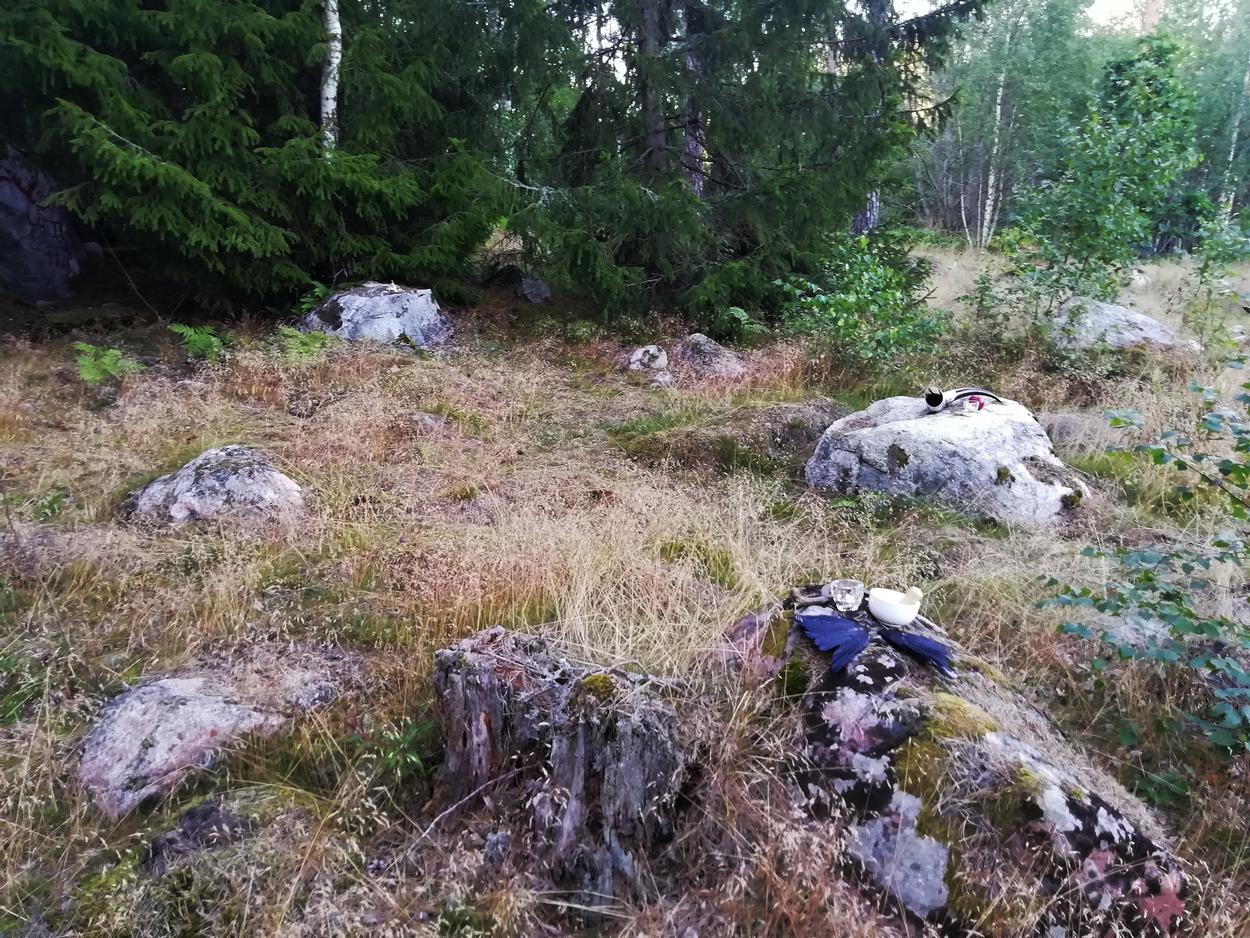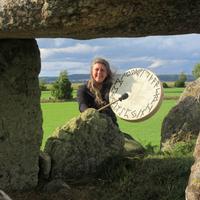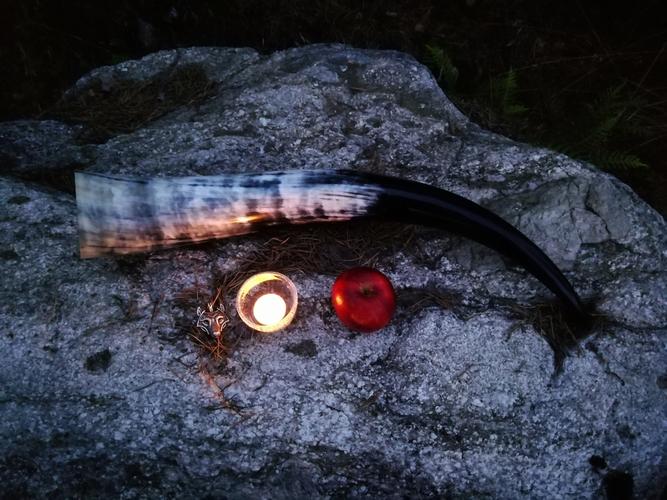He
Tr
One perk of being a teacher is that I have smart students who ask crucial (at times even life-changing!) questions and keep me "on my toes!" In recent years several students from The Netherlands have flown in to attend my courses (in both London and Sweden) and they all asked the same question: “You profile yourself as a teacher of Seidr and Northern European (Norse) ancestral wisdom teachings. Yet your nationality is Dutch and you speak fluent Dutch. Would you ever consider teaching a course in the indigenous, as in pre-Christian (or non-Christian), spiritual heritage of The Netherlands?"
Initially my reply was non-committal: “Who knows, one day perhaps…. “ (secretly thinking this was not something I was going to prioritise in any way!) Then the question was asked again and the person asking added: “Perhaps you will even write a book about this, a book that many people are waiting for!” – I surprised myself by starting that book two weeks ago. The material has already "got to me".
A few other events coincided (such as my mother becoming quite elderly and that bringing the necessity of me spending more time in The Netherlands). A few weeks ago, when my last course for the academic year was done, I asked my contacts in the Netherlands to recommend books and links – and took the plunge. So far the journey has been both fascinating and enlightening. I will share more as this project unfolds.
Today’s blog is about three ancient goddesses that were indigenous to The Netherlands (but please note that there were others too!) If we include the Matrones, there were many goddesses indeed. About 1,100 different stones with description to the matronae have been found (so far).
The Matronae (also Matres, Matrae and marrae) were ancestral (or tribal) mothers, mother-deities, worshipped in an area that stretched from Upper Italy to the part of Germania and Gaul occupied by the Romans (and even beyond into Frisia, Scotland and Northern Spain). The (limited but tantalising) information we have comes from inscriptions on votive stones and altars. Half of those matrons bear Germanic names. These matronae were very local (connected to specific locations and regions). Please note that this information has been adapted from Rudoph Simek’s Dictionary of Northern Mythology. See also: https://en.wikipedia.org/wiki/Matres_and_Matronae
These mother deities all had different areas of focus and responsibility: they were tribal mothers, mothers of rivers, mothers of towns, mothers of clans and so forth. They are often called “deae” as well, the Latin word for goddesses. They were goddesses of healing, prosperity, justice, fate, abundance, war, oaths and pledges, fortune…
This material suggests that Old Europe may well have been matriarchal before we entered the current era of patriarchy. (Might it even mean that our current climate is a reaction to this, the memory of this shrouded in the mists of time?!) More about this subject in the future!
Much as I love reading about ancient goddesses, I am not an academic! For me direct experience and personal revelation are the key to learning and building a relationship to Divinity.
Behind our house here in Sweden we have large earthbound rocks that (roughly) form a circle. I think of this as “our personal stone circle”. This week I received guidance to turn this area into an outdoor temple dedicated to three ancient goddesses from The Low Lands, for one night. (Other nights it often serves as a Moon Observatory!)
These goddesses were: Nehalennia, Hludana and Tanfana.
Nehalennia
“In an island of the ocean stands a sacred and unviolated grove, in which is a consecrated chariot, covered with a veil, which the priest alone is permitted to touch. He becomes conscious of the entrance of the goddess into this secret recess; and with profound veneration attends the vehicle, which is drawn by yoked cows. At this season, all is joy; and every place which the goddess deigns to visit is a scene of festivity. No wars are undertaken; arms are untouched; and every hostile weapon is shut up. Peace abroad and at home are then only known; then only loved; till at length the same priest reconducts the goddess, satiated with mortal intercourse, to her temple. The chariot, with its curtain, and, if we may believe it, the goddess herself, then undergo ablution in a secret lake. This office is performed by slaves, whom the same lake instantly swallows up.”
“Some of the Suevi also perform sacred rites to Isis. What was the cause and origin of this foreign worship, I have not been able to discover; further than that her being represented with the symbol of a galley, seems to indicate an imported religion.”
- Description written by Tacitus, Germania 40, 9 (98 AD) quoted by Maria Kvilhaug
In 1647 gale-force winds swept the dunes of Colijnsplaat, near the village of Domburg, on the Dutch island of Walcheren, and exposed twenty-eight altar stones and other votive objects: an ancient temple dedicated to the goddess Nehalennia had been found!
Scholars and authors do not agree on their interpretations of the name Nehalennia. Some think that her name implies that she was a “death goddess” (based on the Latin word necare – to kill) while others think that her name reflects that she was a River Goddess (ne = new, hel = stream/river and ennia = goddess). One author even claims that she gave her name to “The Netherlands” but that seems fanciful and very unlikely to me, as The Netherlands is literally another way of saying “The Low Lands”. As part of The Netherlands (where my elderly mother lives as it happens!) in West Frisia is below sea level, there is nothing mysterious about this name.
Nehalennia’s attributes are a ship and rudder, a dog and apples (sometimes baskets holding other types of fruit as well). However her most striking attribute is a horn, possibly a cornucopia or Horn of Plenty. She is generally perceived as a goddess of water: streams, river, the ocean, and seafaring.
Hludana
The second goddess I felt called to include in my work is Hludana.
In the village of Beetgum, Friesland (the Netherlands) in 1888, a votive stone was found with the following inscription:
“To the goddess Hludana, the tenants of the fishery, when Quintus Valerius Secundus was head tenant, paid their due, willing and according to what they have earned.”
The name of Hludana appears also (sometimes spelled in slightly different ways) on several stones in the Netherlands and Germany. Indeed, the image of a sitting woman on the stone and the inscription – the Latin name and language, the connection with water, boats and trade – recall the votive stones of Nehalennia.
Scholars debate whether she may be linked to (or even identified as) the old Norse goddess Hlóðynn, mentioned in de V?luspa, Gylfaginning and Skáldskaparmál, mother of Þórr (Thor) and/or Víðarr. Others claim that she may be related to Holda (Frau Holle – German, Vrouw Holle – Dutch). We have only five votive stones to go on!
Click here to watch an art video about Frau Holle. Alternatively, as the linking function is acting up today, please paste the following link in your browser: https://www.youtube.com/watch?v=9pB5iiXMSrY
Hludana was probably a goddess of fishing. Like Nehalennia she was connected to both the sea and rivers. The Dutch people where a sea-faring nation and they did a lot of fishing in their Low Lands by the sea. They were also keen traders and “natural born businessmen” (and remain so until today!)
Tanfana
The goddess Tanfana (sometimes we also find the spelling Tamfana), from the Twente area in the eastern part of the Netherlands, had very different energy. Once again we find debates (and disagreements) about the origin of her name. Fana is a Latin word meaning “temples” and Tan is the German word for pine tree (think of the Christmas song: O Tannenbaum).
Tacitus gives a (gruesome!) description of how forces led by Germanicus massacred the men, women, and children of the Marsi, during the night of a major festival, near the location of a temple dedicated to Tanfana. (I have chosen not to reproduce this passage here).
Dutch author Ineke Bergman says that Tanfana lives on in the Dutch children’s verse Anneke, Tanneke, Toverheks:
Anneke Tanneke Toverheks
Waar ga jij wel naartoe
Ik trek de hele wereld rond
En word dan toch niet moe
Maar ikke wel, riep toen de hond
En gooide Anneke op de grond (2x)
Anneke Tanneke Magical Witch
Where are you off to?
I travel around the world
But it doesn’t tire me.
But does tire me, called the dog!
And threw Anneke on the floor (2x)
Anneke gauw weer opstond
Ging zonder hond de wereld rond
Vloeg toen op haar bezemsteel
Naar haar roze luchtkasteel
De hond toen Janneke daar zien staan
Die blaft naar haar de volle maan (2x)
Anneke got up quickly
Travelled the world without the dog
Then flew on her broomstick
To her pink castle in the clouds
The dog saw Janneke standing there
He barks at her, the full moon (2x)
Listen to this song on YouTube
If this song is indeed about Tanfana, then Tanfana, who became demonized and dismissed a witch in Christian times, would have been a healer and quite possibly death goddess in pre-Christian times. And we can see her standing on the moon, we can also catch a glimpse of her pink castle in the clouds!
My ceremony and outdoor temple
I created three separate altars to these goddesses. I tried to choose objects that reflected their nature and attributes (insofar as we know them). I lit candles on all three altar stones and spoke an invocation, asked to be guided by them and enter into a relationship with them.
Nehalennia received a large horn, an apple and a wolf pendant (I did not have a dog!) She requested I add some zoute drop (salty liquorice, typically Dutch!), which I did.
Hludana was offered a small sailing boat, fishes and shells – but she requested a bowl of water and talked to me about water, the Well of Wisdom, and scrying!
I gave Tanfana a pair of crow’s wings (for flying around the world) and my sickle (to symbolise her death/rebirth and psycho pomp or soul conductor aspect).
I spent time sitting out in the stone circle seeking an audience with all three deities. As darkness descended the stone circle and three altars changed character. The hidden aspects of these three goddesses became visible and their power tangible. I received an invitation to continue working with all three of them in a unique way. All three of them shared information with me that I will research and ponder deeply while working on this new book.
If this piece of work speaks to you – I invite you to contact them too, in your own way and your own location!
And keep me posted of what you find and experience please!
Imelda Almqvist, Sweden, Black Moon, 31 July 2019
Imelda Almqvist is an international teacher of sacred art, seiðr and the ancestral wisdom teachings of Northern Europe. Her first book Natural Born Shamans: A Spiritual Toolkit For Life (Using shamanism creatively with young people of all ages) was published by Moon Books in 2016 and her second book Sacred Art: A Hollow Bone for Spirit (Where Art Meets Shamanism) was published in March 2019. Imelda has presented her work on the Shamanism Global Summit and as a presenter on Year of Ceremony with Sounds True.
Imelda divides her time between the UK, Sweden and the US. Her third book “Medicine of the Imagination: Dwelling in Possibility” will be published in 2020. She has started her fourth book "Evolving Gods: The Sacred Marriage of Tradition and Innovation" and even a fifth book about the indigenous non-Christian spirituality of the Netherlands.
Imelda recently appeared on a Mystic Britain TV programme filmed for The Smithsonian Channel, talking about Mesolithic site Star Carr and arctic deer shamanism, (and modelling a Stone Age antlered headdress!)
Imelda dreams of being a full-time forest witch!


